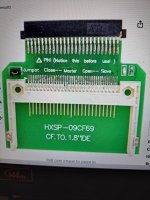CF to IDE adapters are entirely passive, they're nothing more than an interface converter.
Your problem is going to be the CF card. A CF card is an LBA block device, and requires an IDE controller that supports LBA for it to be addressed. In early IDE, LBA was only an optional part of the specification and not all controllers support it. Anything pre-1996 is likely not going to support LBA, but there were some later machines that lacked LBA support.
There are some CF cards that have additional logic to present themselves to the host controller with a CHS addressing scheme, and do CHS to LBA translation in the CF card, but those are a bit difficult to find. If the BIOS in your machine has a USER type 47 in the hard drive selection, you can try and fudge numbers for the cylinders, heads (don't go over 255) and sectors to get the maximum possible capacity and see if it works. If that's not available, you can try to select one of the 46 drive types with the maximum capacity and see if that works.
Try to keep your drive size within reason, don't expect huge multi-gigabyte capacities to work. Your BIOS could have one of several int13h geometry limitations. If it entirely lacks LBA, it may be as low as 528 MB. There's a danger that fudging numbers too high could cause the BIOS to crash. There were some pretty terrible disk handling routines in some BIOS releases that weren't properly bounds checked and could cause stack smashing and either crash or cause extremely errant behavior. This goes double for the auto detect functionality, I've seen where the CHS values weren't bounds checked, and on large drives, they'd end up stack smashing due to writing values out of bounds and go off into lala land.
Something else you could try is a disk on module, which are often used in industrial boards. Just search for "IDE DOM" on Ebay and get a smaller one.


